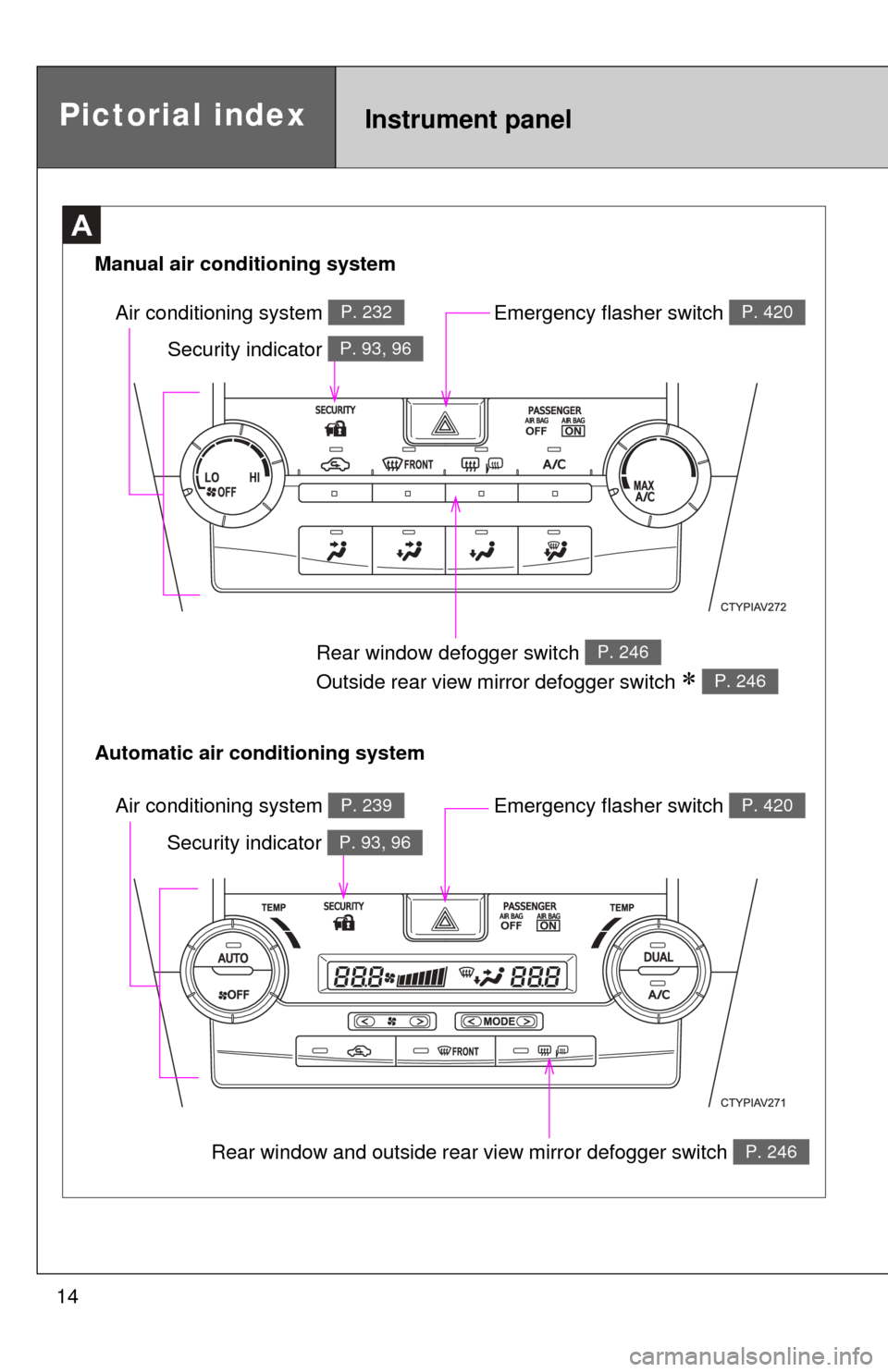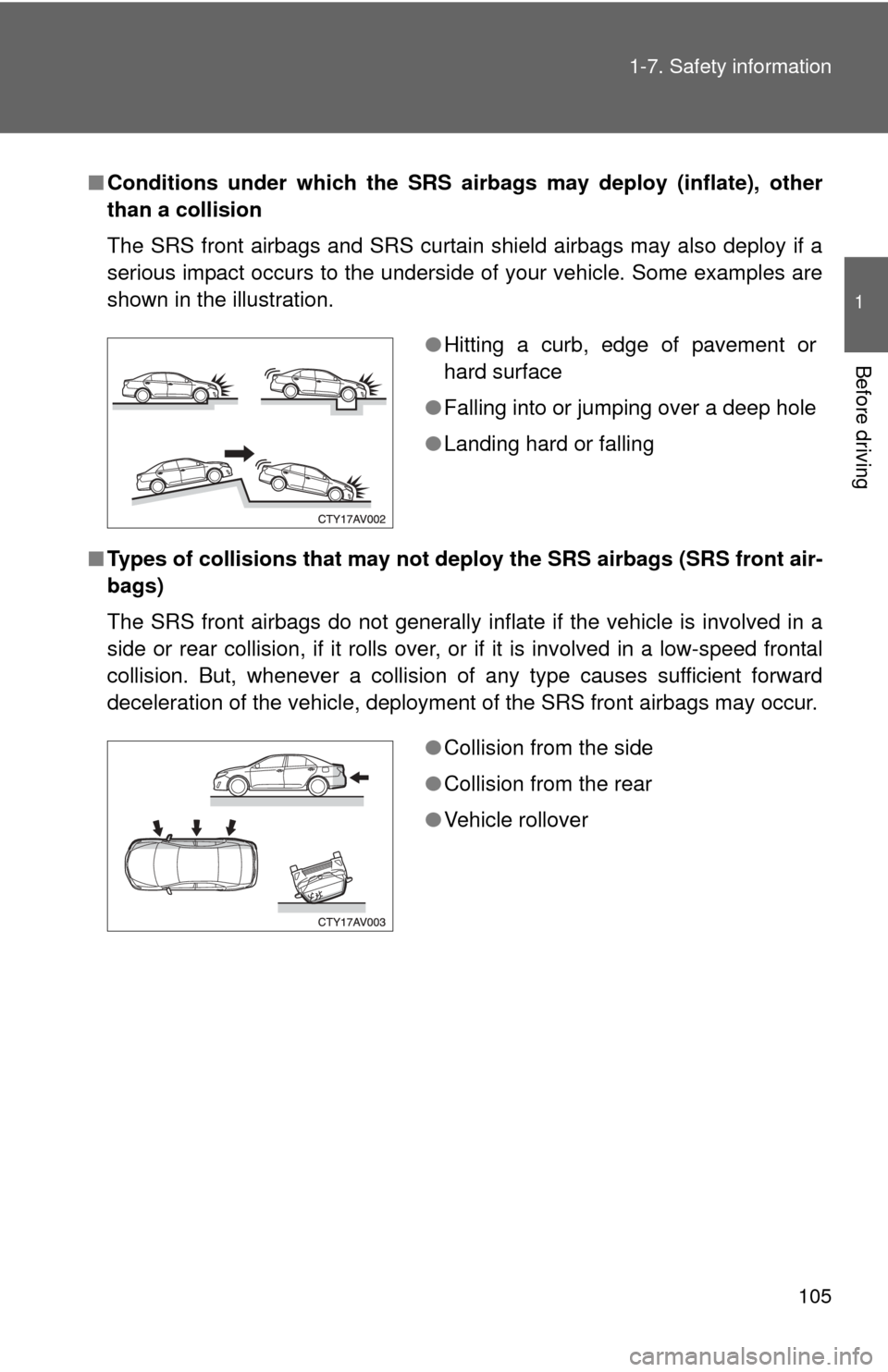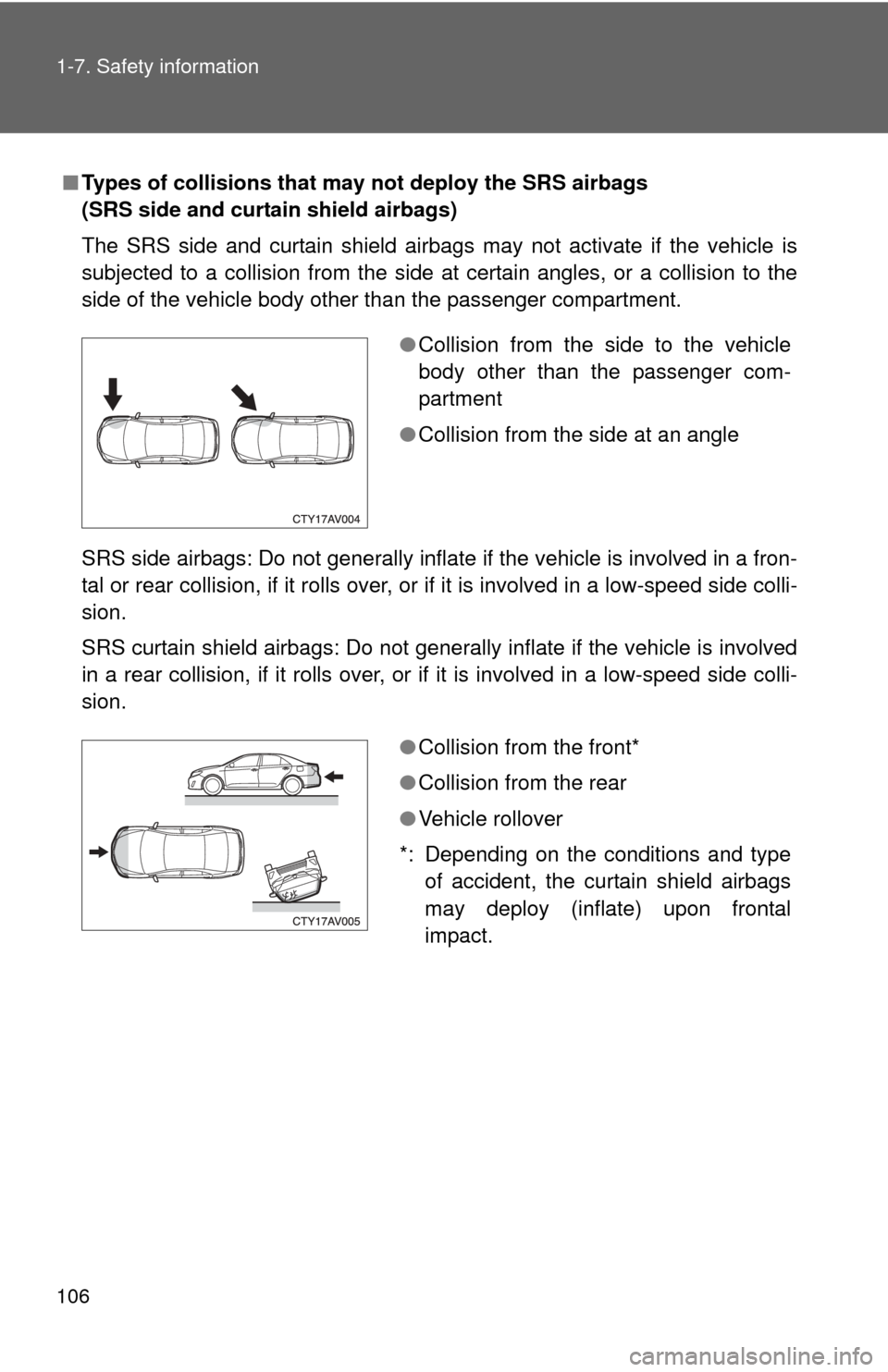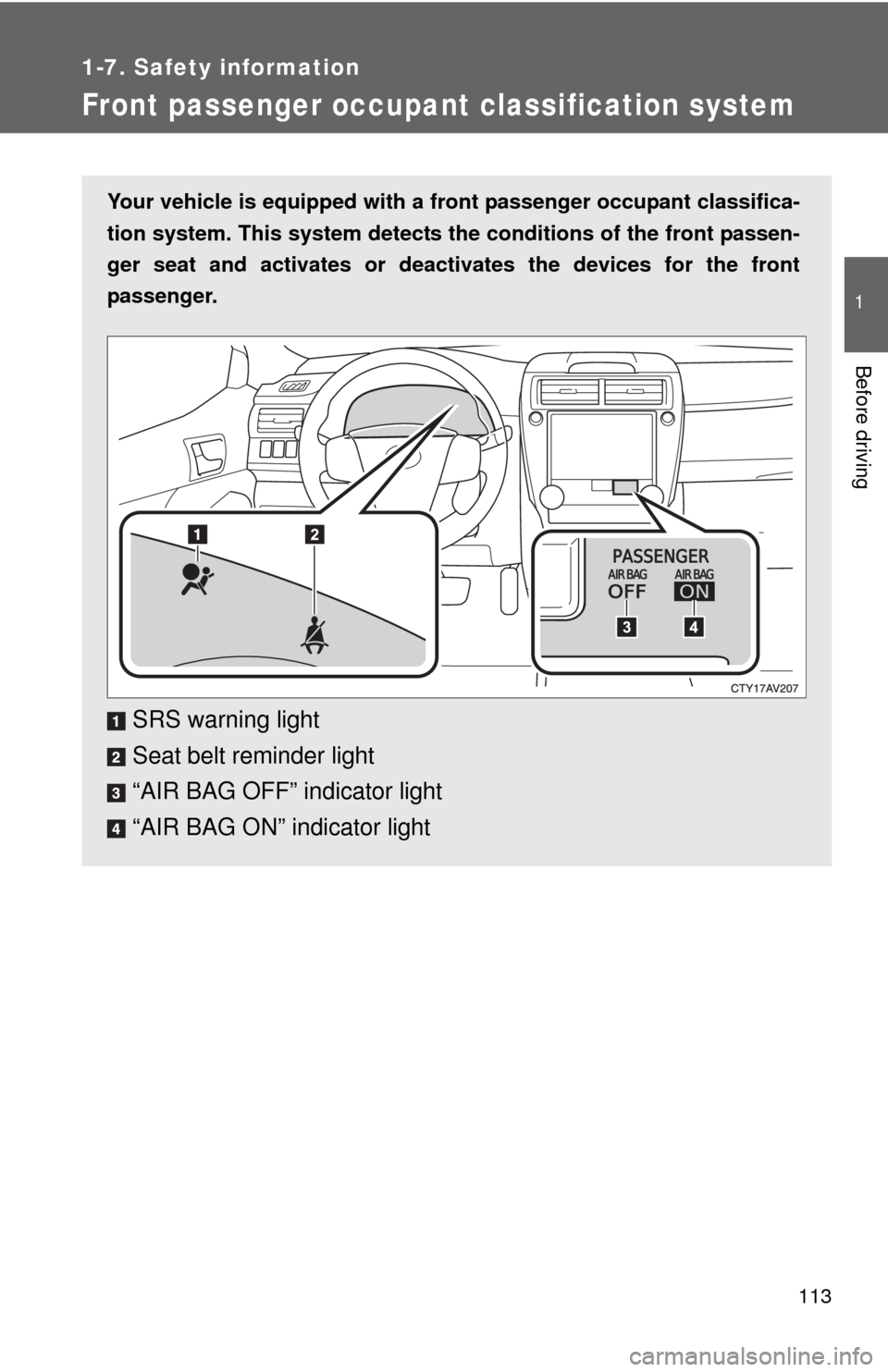air condition TOYOTA CAMRY 2013 XV50 / 9.G Owners Manual
[x] Cancel search | Manufacturer: TOYOTA, Model Year: 2013, Model line: CAMRY, Model: TOYOTA CAMRY 2013 XV50 / 9.GPages: 540, PDF Size: 7 MB
Page 1 of 540

TABLE OF CONTENTS
1
1Before drivingAdjusting and operating features such as door locks,
mirrors, and steering column.
2When drivingDriving, stopping and safe-driving information.
3Interior fea-
turesAir conditioning and audio systems, as well as other in-
terior features for a comfortable driving experience.
4Maintenance
and careCleaning and protecting your vehicle, performing do-it-
yourself maintenance, and maintenance information.
5When trouble
arisesWhat to do if the vehicle needs to be towed, gets a flat
tire, or is involved in an accident.
6Vehicle
specificationsDetailed vehicle information.
7For ownersReporting safety defects for U.S. owners, and seat belt
and SRS airbag instructions for Canadian owners
IndexAlphabetical listing of information contained in this
manual.
Page 3 of 540

1
2
3
4
5
6
7
3
2-2. Instrument clusterGauges and meters ............ 170
Indicators and warning lights ................................. 180
2-3. Operating the lights and wipers
Headlight switch .................. 186
Fog light switch ................... 193
Windshield wipers and washer .............................. 195
2-4. Using other driving systems
Cruise control ...................... 200
Driving assist systems ........ 204
BSM (Blind Spot Monitor) ... 209
2-5. Driving information Cargo and luggage ............. 219
Vehicle load limits ............... 223
Winter driving tips ............... 224
Trailer towing ...................... 228
Dinghy towing ..................... 229 3-1. Using the air conditioning
system and defogger
Manual air conditioning system .............................. 232
Automatic air conditioning system .............................. 239
Rear window and outside rear view mirror
defoggers ......................... 246
3-2. Using the audio system Audio system types ............ 248
Using the radio ................... 253
Using the CD player ........... 256
Playing back MP3 and WMA discs ....................... 262
Operating an iPod .............. 270
Operating a USB memory ............................ 279
Optimal use of the audio system .............................. 287
Using the AUX port............. 290
3-3. Using the interior lights Interior lights list ................. 292
• Interior lights..................... 293
• Personal lights.................. 294
3Interior features
Page 4 of 540

TABLE OF CONTENTSIndex
4
3-4. Using the storage featuresList of storage features....... 296
• Glove box ......................... 297
• Console box ..................... 298
• Coin holder ....................... 299
• Bottle holders ................... 300
• Cup holders ...................... 301
• Auxiliary boxes ................. 303
3-5. Other interior features Sun visors .......................... 305
Vanity mirrors ..................... 306
Clock .................................. 307
Outside temperature display .............................. 308
Ashtray ............................... 310
Power outlets ..................... 311
Seat heaters ....................... 314
Armrest............................... 316
Assist grips ......................... 317
Coat hooks ......................... 318
Floor mat ............................ 319
Trunk features .................... 321
Garage door opener ........... 323
Compass ............................ 330
Safety Connect................... 334 4-1. Maintenance and care
Cleaning and protecting the vehicle exterior ........... 342
Cleaning and protecting the vehicle interior ............ 345
4-2. Maintenance Maintenance requirements .................... 348
General maintenance ......... 351
Emission inspection and maintenance (I/M)
programs .......................... 355
4-3. Do-it-yourself maintenance Do-it-yourself service precautions ....................... 356
Hood ................................... 359
Positioning a floor jack........ 360
Engine compartment .......... 362
Tires.................................... 376
Tire inflation pressure ......... 382
Wheels................................ 386
Air conditioning filter ........... 389
Wireless remote control/ electronic key battery ....... 391
Checking and replacing fuses ................................. 396
Light bulbs .......................... 408
4Maintenance and care
Page 14 of 540

14Rear window and outside rear view mirror defogger switch
P. 246
A
Air conditioning system P. 239
Rear window defogger switch
Outside rear view mirror defogger switch
P. 246
P. 246
Air conditioning system P. 232
Pictorial indexInstrument panel
Automatic air conditioning system Manual air conditioning system
Emergency flasher switch P. 420
Emergency flasher switch P. 420
Security indicator P. 93, 96
Security indicator P. 93, 96
Page 40 of 540

40 1-2. Opening, closing and locking the doors and trunk
■Conditions affecting operation
The smart key system uses weak radio waves. In the following situations,
the communication between the electronic key and the vehicle may be
affected, preventing the smart key system, wireless remote control and
engine immobilizer system from operating properly.
(Ways of coping: P. 457)
● When the electronic key battery is depleted
● Near a TV tower, electric power plant, gas station, radio station, large dis-
play, airport or other facility that generates strong radio waves or electri-
cal noise
● When the electronic key is in contact with, or is covered by the following
metallic objects
• Cards to which aluminum foil is attached
• Cigarette boxes that have aluminum foil inside
• Metallic wallets or bags
• Coins
• Hand warmers made of metal
• Media such as CDs and DVDs
● When other wireless key (that emit radio waves) is being used nearby
● When carrying the electronic key together with the following devices that
emit radio waves
• A portable radio, cellular phone, cordless phone or other wireless com-
munication device
• Another vehicle’s electronic key or a wireless key that emits radio waves
• Personal computers or personal digital assistants (PDAs)
• Digital audio players
• Portable game systems
● If window tint with a metallic content or metallic objects are attached to
the rear window
● When the electronic key is placed near a battery charger or electronic
devices
Page 49 of 540

49
1-2. Opening, closing and locking the doors and trunk
1
Before driving
Vehicles with a smart key system
■ Security feature
If a door is not opened within approximately 60 seconds after the vehicle is
unlocked, the security feature automatically locks the vehicle again.
■ Alarm (if equipped)
Using the wireless remote control to lock the doors will set the alarm system.
(P. 96)
■ Conditions affecting operation
Vehicles without a smart key system
The wireless remote control function may not operate normally in the follow-
ing situations:
●When the wireless key battery is depleted
● Near a TV tower, electric power plant, gas station, radio station, large dis-
play, airport or other facility that generates strong radio waves or electri-
cal noise
● When carrying a portable radio, cell ular phone or other wireless commu-
nication devices
● When the wireless key is in contact with, or is covered by a metallic
object
● When other wireless key (that emit radio waves) is being used nearby
● If window tint with a metallic content or metallic objects are attached to
the rear window
Vehicles with a smart key system
P. 4 0
When is pressed for longer
than about one second, an alarm will
sound intermittently and the vehicle
lights will flash to deter any person from
trying to break into or damage your
vehicle.
To stop the alarm, press any button on
the electronic key.
Page 104 of 540

104 1-7. Safety information
■SRS airbag deployment conditions (SRS front airbags)
●The SRS front airbags will deploy in the event of an impact that exceeds
the set threshold level (the level of force corresponding to an approxi-
mately 12 - 18 mph [20 - 30 km/h] frontal collision with a fixed wall that
does not move or deform).
However, this threshold velocity will be considerably higher if the vehicle
strikes an object, such as a parked vehicle and sign pole, which can move
or deform on impact, or if the vehicle is involved in an underride collision
(e.g. a collision in which the front of the vehicle “underrides”, or goes
under, the bed of a truck etc.).
● Depending on the type of collision, it is possible that only the seat belt
pretensioners will activate.
● The SRS front airbags for the front passenger will not activate if there is
no passenger sitting in the front passenger seat. However, the SRS front
airbags for the front passenger may deploy if luggage is put in the seat,
even if the seat is unoccupied. ( P. 113)
■ SRS airbag deployment conditions (S RS side and curtain shield air-
bags)
● The SRS side and curtain shield airbags will deploy in the event of an
impact that exceeds the set threshold level (the level of force corre-
sponding to the impact force produced by an approximately 3300 lb.
[1500 kg] vehicle colliding with the vehicle cabin from a direction perpen-
dicular to the vehicle orientation at an approximate speed of 12 - 18 mph
[20 - 30 km/h]).
● The SRS curtain shield airbags may also deploy in the event of a severe
frontal collision.
Page 105 of 540

105
1-7. Safety information
1
Before driving
■
Conditions under which the SRS airbags may deploy (inflate), other
than a collision
The SRS front airbags and SRS curtain shield airbags may also deploy if a
serious impact occurs to the underside of your vehicle. Some examples are
shown in the illustration.
■ Types of collisions that may not de ploy the SRS airbags (SRS front air-
bags)
The SRS front airbags do not generally inflate if the vehicle is involved in a
side or rear collision, if it rolls over, or if it is involved in a low-speed frontal
collision. But, whenever a collision of any type causes sufficient forward
deceleration of the vehicle, deployment of the SRS front airbags may occur.
● Hitting a curb, edge of pavement or
hard surface
● Falling into or jumping over a deep hole
● Landing hard or falling
●Collision from the side
● Collision from the rear
● Vehicle rollover
Page 106 of 540

106 1-7. Safety information
■Types of collisions that may not deploy the SRS airbags
(SRS side and curtain shield airbags)
The SRS side and curtain shield airbags may not activate if the vehicle is
subjected to a collision from the side at certain angles, or a collision to the
side of the vehicle body other than the passenger compartment.
SRS side airbags: Do not generally inflate if the vehicle is involved in a fron-
tal or rear collision, if it rolls over, or if it is involved in a low-speed side colli-
sion.
SRS curtain shield airbags: Do not generally inflate if the vehicle is involved
in a rear collision, if it rolls over, or if it is involved in a low-speed side colli-
sion.
●Collision from the side to the vehicle
body other than the passenger com-
partment
● Collision from the side at an angle
●Collision from the front*
● Collision from the rear
● Vehicle rollover
*: Depending on the conditions and type of accident, the curtain shield airbags
may deploy (inflate) upon frontal
impact.
Page 113 of 540

113
1
1-7. Safety information
Before driving
Front passenger occupant classification system
Your vehicle is equipped with a front passenger occupant classifica-
tion system. This system detects the conditions of the front passen-
ger seat and activates or deactiv ates the devices for the front
passenger.
SRS warning light
Seat belt reminder light
“AIR BAG OFF” indicator light
“AIR BAG ON” indicator light